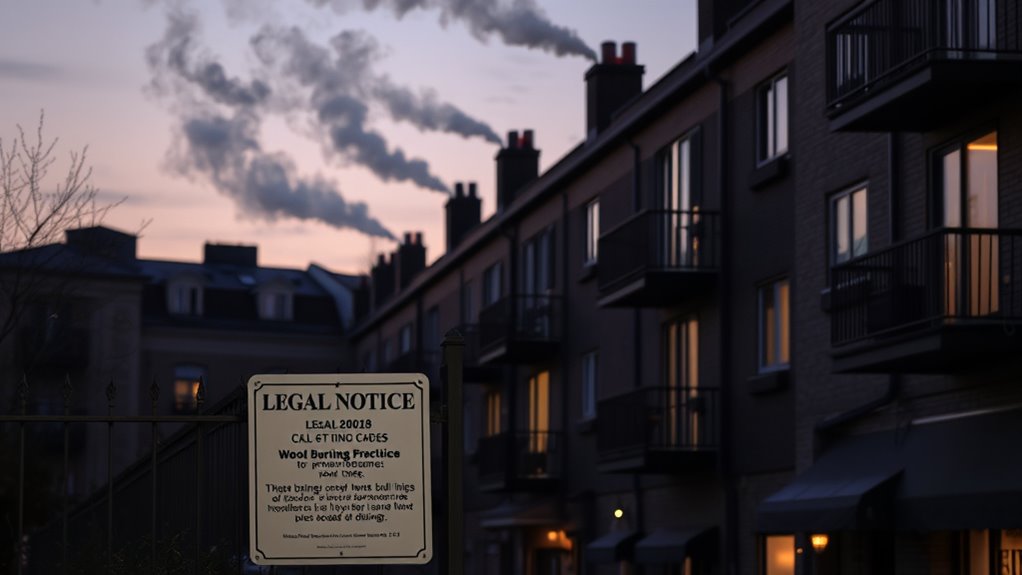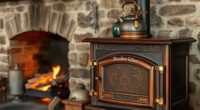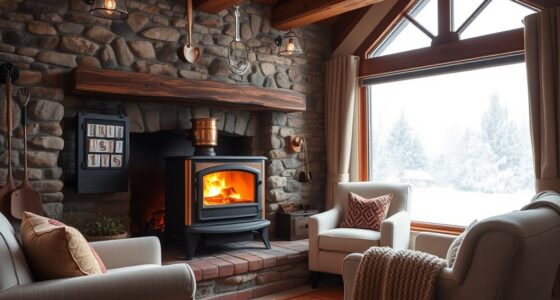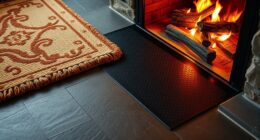In most urban areas, laws about wood burning vary widely to protect air quality and public health. You may face restrictions like bans on uncertified stoves, permit requirements for installations, and setback rules to reduce smoke exposure. Local and federal regulations aim to reduce harmful emissions and encourage upgrades to cleaner heating options. As policies evolve, understanding specific local rules is key—stay tuned to learn how these regulations could impact your home or community.
Key Takeaways
- Local laws and regulations vary, often requiring permits and adherence to emission standards for residential wood burning.
- EPA-certified appliances are typically mandated, with non-certified units needing upgrades or removal to comply with legal standards.
- Restrictions on outdoor boilers and fireplaces include setback requirements and emission limits, enforced by local authorities.
- Inspections verify compliance, and violations can result in fines, permits revocation, or legal action.
- Future policies aim to tighten standards, promoting cleaner heating options and phased elimination of uncertified wood-burning devices.
The Variability of Laws Surrounding Wood Burning
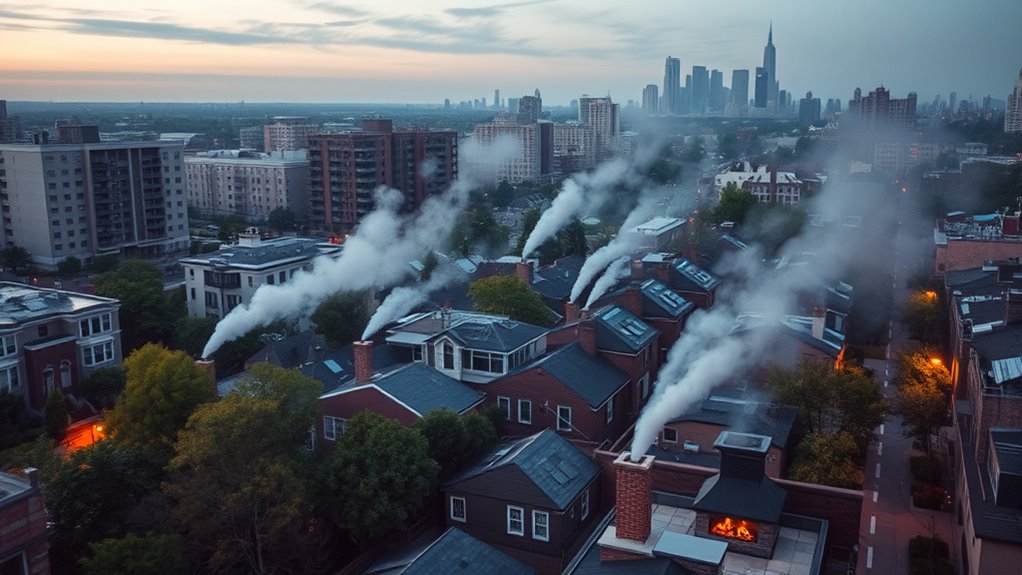
Laws governing wood burning in urban areas differ considerably from one place to another, reflecting local priorities and environmental concerns. EPA regulations set nationwide standards, but local air quality monitors influence specific restrictions to control pollution from wood. Many urban zones enforce emission limits for residential wood heaters, aiming to improve local air quality and protect health outcomes. Some cities ban uncertified stoves or require EPA-certified inserts to reduce harmful emissions. Others prohibit new wood fireplaces altogether, like in California’s Bay Area, to further limit pollution from wood. Outdoor boiler restrictions, including setback requirements, also vary. As a result, the legality of wood burning in urban zones evolves frequently, often becoming more restrictive to address environmental and health issues effectively. Emission limits play a crucial role in shaping local regulations and ensuring community health. Additionally, public awareness campaigns are increasingly used to educate residents about the impacts of wood burning and promote cleaner heating alternatives. Recognizing the importance of regulatory compliance, many communities actively update their laws to stay aligned with evolving scientific insights and pollution-control technologies. Furthermore, advances in air quality monitoring technology inform policymakers and residents about pollution levels, prompting more targeted regulations. Moreover, understanding the personality traits of residents can help tailor public outreach to increase compliance and awareness.
Environmental and Health Justifications for Regulations
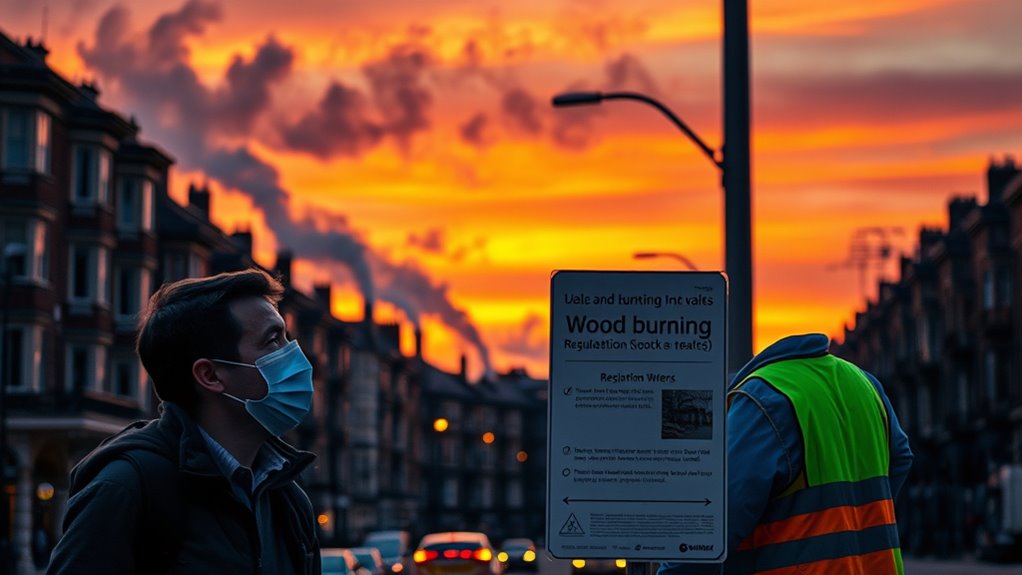
Because wood smoke contains fine particulate matter (PM2.5) that often exceeds air quality standards, regulations are justified to protect public health and the environment. Wood smoke markedly contributes to air pollution, especially in urban areas during winter, affecting air quality and exacerbating health impacts. The emissions from residential wood burning release particulate matter, carbon monoxide, and volatile organic compounds, all of which pose serious respiratory health risks. Studies link exposure to wood smoke with increased cases of asthma, heart disease, and respiratory infections, particularly among vulnerable populations. Implementing regulations like seasonal restrictions, certified appliance mandates, and bans on uncertified stoves helps reduce emissions, improve air quality, and safeguard public health from the harmful effects of wood smoke. Additionally, AI security research underscores the importance of continuous monitoring and regulation to mitigate emerging environmental risks. Moreover, adopting emission reduction strategies can further enhance air quality and public health protection. Recognizing the importance of protective styling techniques, some communities are exploring innovative ways to reduce indoor and outdoor air pollution associated with wood burning. The use of durable survival gear in environmental monitoring can support ongoing efforts to track pollution levels and enforce regulations effectively. Proper combustion techniques also play a crucial role in minimizing harmful emissions and improving combustion efficiency.
Specific Restrictions and Permitting Processes in Urban Settings
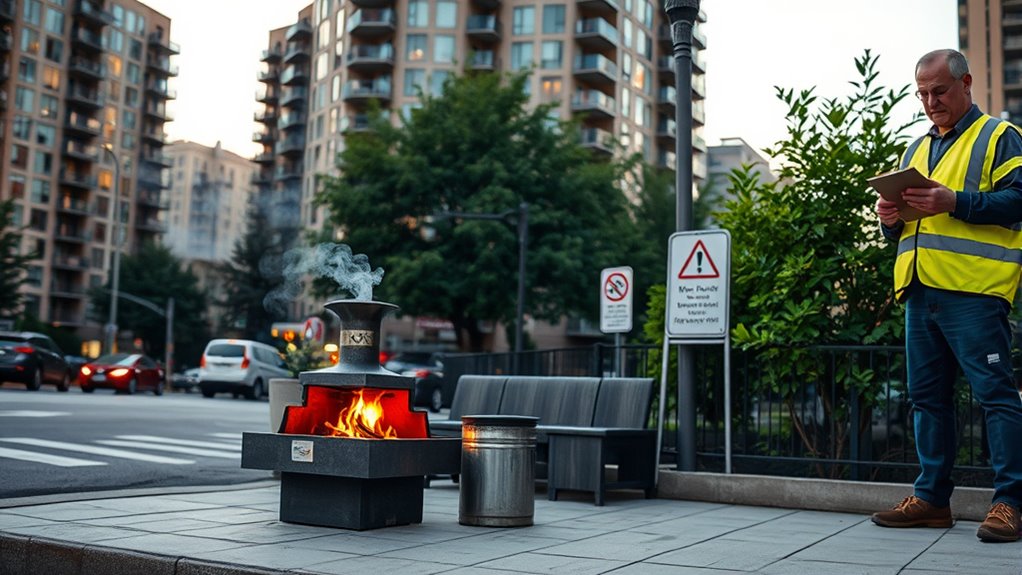
Urban areas often require permits for installing or operating wood-burning appliances to guarantee compliance with local emission standards and minimize air quality impacts. You’ll need to secure permits before installing fireplaces or outdoor boilers, ensuring they meet local ordinances and emission regulations. Many jurisdictions mandate inspections to verify adherence to these standards, especially for existing units being upgraded or replaced. Local rules often specify setbacks from property lines or neighbors to reduce smoke exposure. Some cities restrict or prohibit new fireplaces unless certified to EPA standards, and outdated or non-certified stoves must be upgraded or removed upon sale or renovation. Outdoor boilers are frequently subject to strict emission limits, setbacks, and sometimes outright bans, all aimed at protecting neighborhood air quality. Additionally, smoke separation distances may be enforced to prevent nuisance and health hazards for nearby residents. Incorporating community health concerns into permitting processes helps ensure comprehensive protection for urban populations. Moreover, implementing lifecycle management strategies can further reduce environmental impacts of wood-burning appliances in city settings. Proper ventilation and ongoing maintenance also play a crucial role in meeting regulatory standards and safeguarding public health. A thorough understanding of mechanical failures can help in early detection and prevention of issues that might cause excess emissions or safety hazards.
Upgrading and Transitioning to Cleaner Alternatives
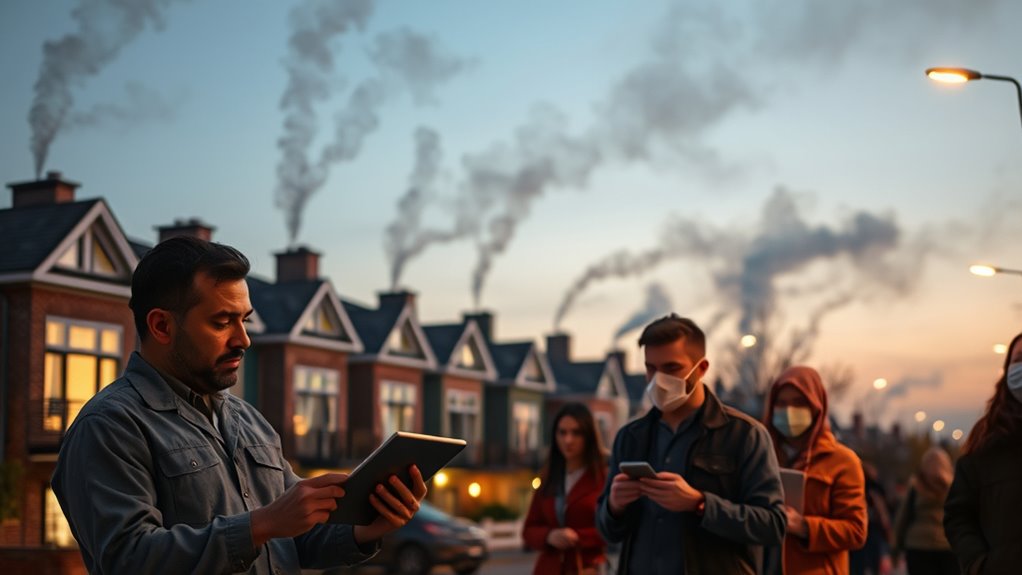
Upgrading existing wood-burning appliances is one of the most effective ways to reduce emissions and improve air quality in your neighborhood. By choosing EPA-certified wood stoves or inserts, you can markedly cut pollution and meet stricter regulations. Converting traditional wood fireplaces to gas or electric options offers cleaner, more efficient heating that’s often exempt from local restrictions. To facilitate this shift, many states provide incentives—averaging over $4,000 for certified heaters and $6,000 for heat pumps—that encourage eco-friendly upgrades. Consider these steps:
- Replace old wood stoves with EPA-certified models.
- Convert fireplaces to gas or electric systems.
- Take advantage of available incentives.
- Stay informed about evolving environmental regulations.
- Incorporating innovative heating solutions can also be harnessed to develop innovative heating solutions that minimize environmental impact. Implementing advanced combustion technology can further improve efficiency and reduce emissions from wood-burning appliances. Additionally, understanding air quality standards is crucial for ensuring long-term compliance and health benefits.
These actions help improve air quality, protect health, and ensure compliance with future pollution standards.
Emerging Trends and Future Policy Developments
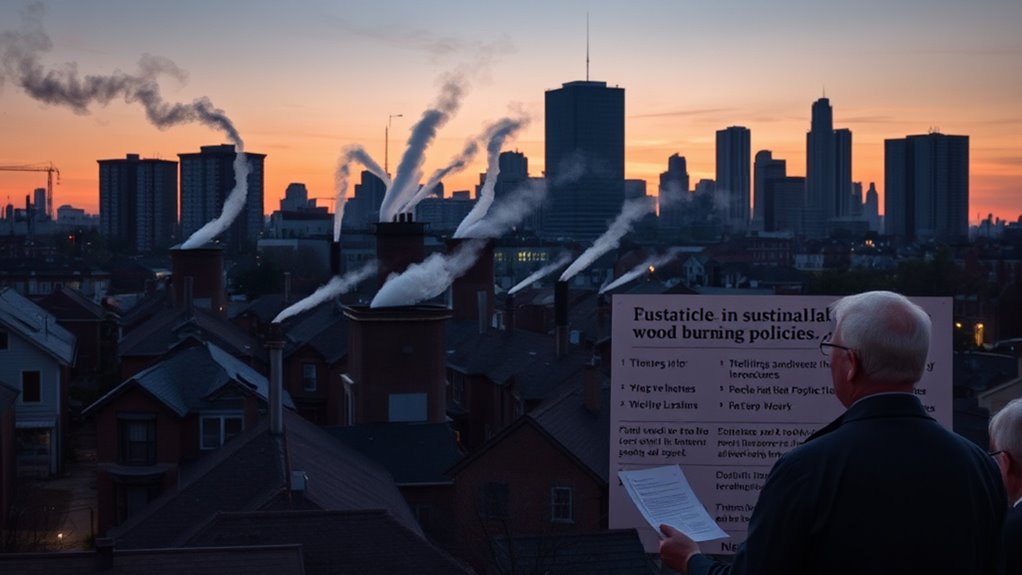
Emerging policies are increasingly prioritizing the adoption of EPA-certified, low-emission wood stoves and the phased removal of uncertified appliances to meet stricter environmental standards. These measures aim to improve air quality and protect public health by enforcing emission limits on residential wood heating devices. Future policy developments include tighter outdoor air pollution controls, especially for outdoor wood boilers, with setback requirements and stricter emission standards. Incentive programs now offer rebates averaging over $4,000 to encourage homeowners to upgrade to cleaner, certified options. As new construction increasingly incorporates eco-friendly heating solutions like gas and electric fireplaces, regulations will likely evolve to favor these sustainable alternatives. Additionally, wood burning emissions are expected to be a key focus in upcoming environmental initiatives, aiming to further reduce particulate matter and improve overall air quality. Incorporating advanced emission reduction technologies into existing systems can significantly help meet these upcoming standards. Understanding spirituality read can inspire communities to adopt more environmentally conscious practices and foster a collective effort toward sustainability. Moreover, ongoing research into air quality monitoring methods will enhance the ability to enforce these policies effectively. For example, implementing air quality sensors in urban areas can provide real-time data to better regulate pollution sources. Overall, future policies aim to balance effective home heating with environmental and public health protections.
Frequently Asked Questions
Is It Against the Law to Burn Wood?
You wonder if burning wood is against the law. It depends on where you live. Many urban areas have rules that restrict or ban wood burning to improve air quality. You might need EPA-certified stoves or permits. Ignoring these rules can lead to fines or penalties. Always check your local regulations before burning wood to stay legal and avoid trouble.
What States Ban Wood Burning Fireplaces?
Imagine a chilly evening where you yearn for the cozy glow of a wood fire. In 2023, states like California, Oregon, Washington, and Colorado have put limits or bans on traditional wood-burning fireplaces, especially in urban areas. They’ve introduced laws requiring EPA-certified stoves or banning uncertified ones altogether. These rules aim to clear the air, but they also mean you’ll need to find alternative ways to stay warm and enjoy that comforting fire.
Is It Illegal to Burn Lumber?
Burning lumber can be illegal depending on where you live, especially if it creates excessive smoke or violates local rules. You might be prohibited from burning treated or painted wood because of toxic fumes. Check your local regulations before burning construction or green lumber, as many areas restrict or ban it to protect air quality. Ignoring these laws could lead to fines or other penalties, so always verify with local authorities.
What Are the EPA Regulations for Wood Burning Stoves?
You want to know EPA regulations for wood burning stoves. The EPA sets emission standards, limiting particulate matter to 2.5 grams per hour for non-catalytic and 1.5 grams for catalytic stoves. All stoves sold or installed after May 15, 2020, must be certified to meet these standards. This means uncertified models are banned, and manufacturers need approval before selling, helping reduce air pollution and protect public health.
Conclusion
Ultimately, understanding the legal landscape of wood burning in cities is like charting a labyrinth of ever-changing rules. You must stay vigilant, as regulations evolve faster than the wind shifts, threatening your very right to enjoy a cozy fire. With stricter bans and cleaner alternatives emerging at lightning speed, you risk being left in the dust—or worse, facing astronomical fines. Stay informed, adapt quickly, or find yourself lost in a maze of legal chaos you never saw coming.

